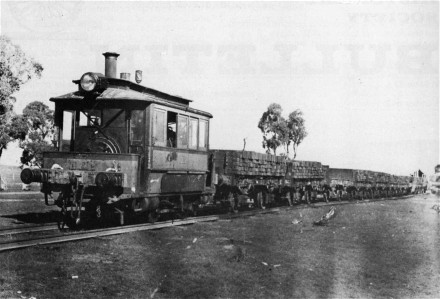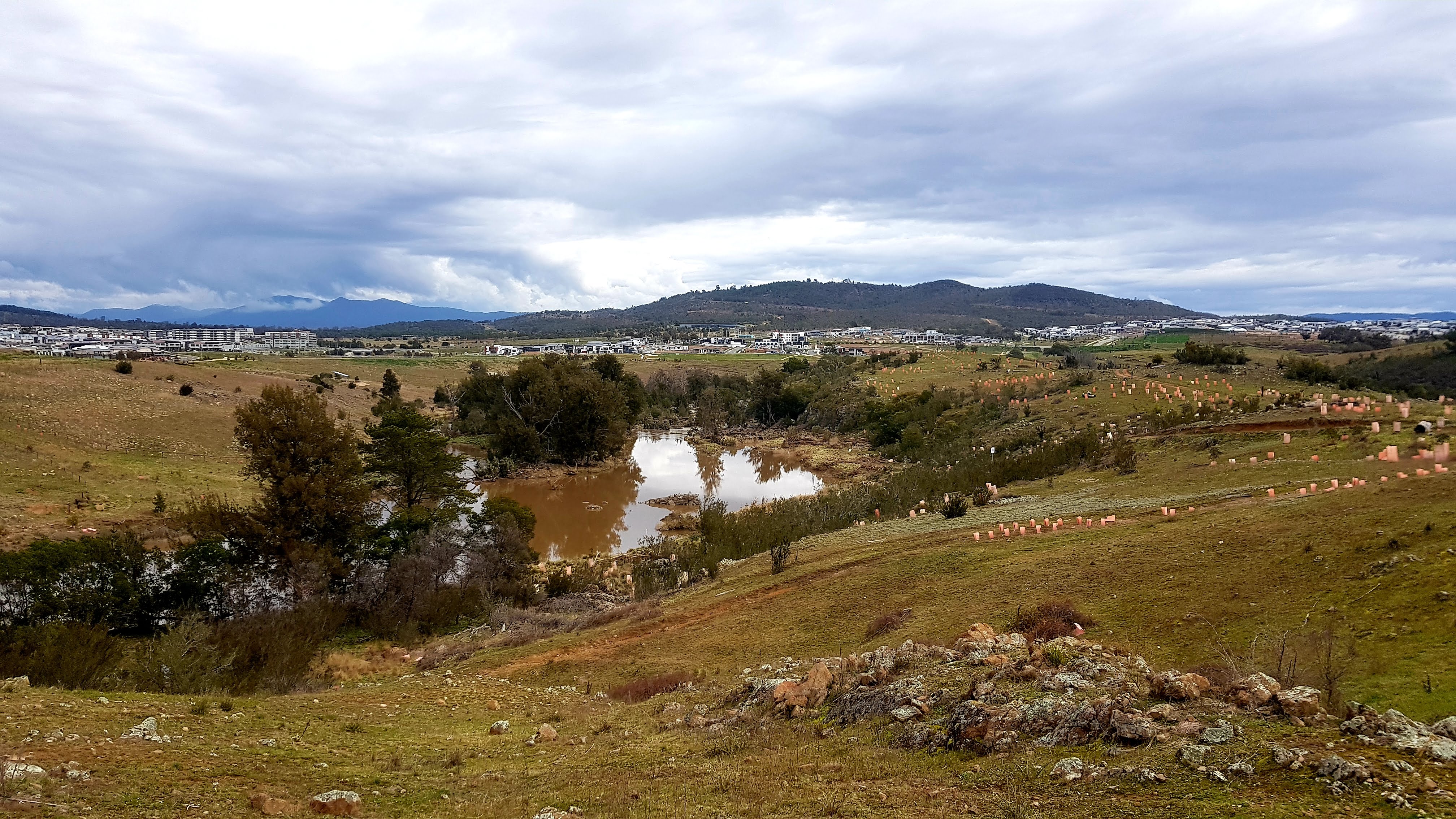|
Captains Flat
Captains Flat is a town in the Southern Tablelands of rural New South Wales, Australia, in Queanbeyan-Palerang Regional Council. It is south of Queanbeyan. Captains Flat township is bounded by the non-urban parts of the locality of Captains Flat in the north, east and west, and Captains Flat Road, the Molonglo River and Foxlow Street in the south. Name It is suggested the town took its name from a white bullock named "Captain" who would slip away from Foxlow station, 12 km away, to graze grassy flatlands near the Molonglo River. History Prior to European settlement, the area was inhabited by Ngarigo Aboriginal people. The town formed as a result of mining for gold, silver, lead, zinc, copper and iron pyrites in the hills surrounding the upper reaches of the Molonglo River. The town boomed from 1881 to 1899, but went into a rapid decline until 1939, when rail access revived mining activity for another 23 years. Mining Copper was found in the area in 1874 by J.E. Wrigh ... [...More Info...] [...Related Items...] OR: [Wikipedia] [Google] [Baidu] |
Europe
Europe is a large peninsula conventionally considered a continent in its own right because of its great physical size and the weight of its history and traditions. Europe is also considered a Continent#Subcontinents, subcontinent of Eurasia and it is located entirely in the Northern Hemisphere and mostly in the Eastern Hemisphere. Comprising the westernmost peninsulas of Eurasia, it shares the continental landmass of Afro-Eurasia with both Africa and Asia. It is bordered by the Arctic Ocean to the north, the Atlantic Ocean to the west, the Mediterranean Sea to the south and Asia to the east. Europe is commonly considered to be Boundaries between the continents of Earth#Asia and Europe, separated from Asia by the drainage divide, watershed of the Ural Mountains, the Ural (river), Ural River, the Caspian Sea, the Greater Caucasus, the Black Sea and the waterways of the Turkish Straits. "Europe" (pp. 68–69); "Asia" (pp. 90–91): "A commonly accepted division between Asia and E ... [...More Info...] [...Related Items...] OR: [Wikipedia] [Google] [Baidu] |
Australian Railway History
''Australian Railway History'' is a monthly magazine covering railway history in Australia, published by the New South Wales Division of the Australian Railway Historical Society on behalf of its state and territory Divisions. Australian Railway Historical Society History and profile It was first published in 1937 as the ''Australasian Railway and Locomotive Historical Society Bulletin'', being renamed ''ARHS Bulletin'' in 1952. In January 2004, the magazine was re-branded as ''Australian Railway History''. Historically, the magazine had a mix of articles dealing with historical material and items on current events drawn from its affiliate publications. Today, it contains only historical articles, two or three of them being in-depth.Parameters * Size : A4; ...[...More Info...] [...Related Items...] OR: [Wikipedia] [Google] [Baidu] |
Krauss
Krauss is a German surname. Notable people with the surname include: * Alison Krauss (born 1971), American bluegrass musician * Alexander Krauß (born 1975), German politician * Alexis Krauss (born 1985), musician of the noise pop duo Sleigh Bells * Anna Krauss (born 1884) German clairvoyant * Beatrice Krauss (1903–1998), American botanist * Clemens Krauss (1893–1954), Austrian conductor * Charles A. W. Krauss (1851–1939), American politician * Christian Ferdinand Friedrich Krauss (1812–1890), known as Ferdinand Krauss, German scientist, traveller and collector * Friedrich Salomon Krauss (1859–1938), Austrian ethnographer * Gabrielle Krauss (1842–1906), Austrian-born French operatic soprano * Georg Krauß, (1826–1906), German industrialist and the founder of the Krauss Locomotive Works ** Krauss-Maffei, German engineering company, named in part after Georg Krauß * Hermann August Krauss (1848–1937), Austrian entomologist * Johan Carl Krauss (1759–1826), German ph ... [...More Info...] [...Related Items...] OR: [Wikipedia] [Google] [Baidu] |
Blast Furnace
A blast furnace is a type of metallurgical furnace used for smelting to produce industrial metals, generally pig iron, but also others such as lead or copper. ''Blast'' refers to the combustion air being "forced" or supplied above atmospheric pressure. In a blast furnace, fuel ( coke), ores, and flux (limestone) are continuously supplied through the top of the furnace, while a hot blast of air (sometimes with oxygen enrichment) is blown into the lower section of the furnace through a series of pipes called tuyeres, so that the chemical reactions take place throughout the furnace as the material falls downward. The end products are usually molten metal and slag phases tapped from the bottom, and waste gases (flue gas) exiting from the top of the furnace. The downward flow of the ore along with the flux in contact with an upflow of hot, carbon monoxide-rich combustion gases is a countercurrent exchange and chemical reaction process. In contrast, air furnaces (such as reverbera ... [...More Info...] [...Related Items...] OR: [Wikipedia] [Google] [Baidu] |
Captains Flat Railway Line
The Captains Flat railway line was a country branch line in the Southern Tablelands region of New South Wales. The line branched off the Bombala line at Bungendore Junction, 5 km south of Bungendore and terminated 34 km further south at Captain's Flat. Mining leads to a call for a railway Mining activity at Captains Flat began in 1882 on copper ore bodies. A railway connection from Bungendore to Captains Flat to support mining operations was considered as early as 1897, but the poor performance of the mine meant that a railway would not be economically viable. As the depth of mining increased, the constitution of the lode changed and the ore proved too complex to treat. From 1899 to 1926, production continued on a restricted basis but, during that period, technological improvements were made which meant that the lode could be economically mined. A pilot plant was erected to demonstrate the practicability of renewed mining."The Bungendore to Captain's Flat Branch Li ... [...More Info...] [...Related Items...] OR: [Wikipedia] [Google] [Baidu] |
Molonglo River
The Molonglo River, a perennial river that is part of the Murrumbidgee catchment within the Murray–Darling basin, is located in the Monaro and Capital Country regions of New South Wales and the Australian Capital Territory, in Australia. Location and features The river rises on the western side of the Great Dividing Range, in Tallaganda State Forest at and flows generally from south to north before turning northwest, through Carwoola and the outskirts of Queanbeyan, where it has confluence with its major tributary, the Queanbeyan River, and then continues through Canberra, where it has been dammed by the Scrivener Dam to form Lake Burley Griffin. The river then flows to its mouth with the Murrumbidgee River, near Uriarra Crossing. Over its course the Molonglo River alternates between long broad floodplains and narrow rocky gorges several times. One of these floodplains is called the Molonglo Plain. From source to mouth, the river is traversed by the Captains Flat Road at ... [...More Info...] [...Related Items...] OR: [Wikipedia] [Google] [Baidu] |
Pyrite
The mineral pyrite (), or iron pyrite, also known as fool's gold, is an iron sulfide with the chemical formula Iron, FeSulfur, S2 (iron (II) disulfide). Pyrite is the most abundant sulfide mineral. Pyrite's metallic Luster (mineralogy), luster and pale brass-yellow hue give it a superficial resemblance to gold, hence the well-known nickname of ''fool's gold''. The color has also led to the nicknames ''brass'', ''brazzle'', and ''Brazil'', primarily used to refer to pyrite found in coal. The name ''pyrite'' is derived from the Greek language, Greek (), 'stone or mineral which strikes fire', in turn from (), 'fire'. In ancient Roman times, this name was applied to several types of stone that would create sparks when struck against steel; Pliny the Elder described one of them as being brassy, almost certainly a reference to what we now call pyrite. By Georgius Agricola's time, , the term had become a generic term for all of the pyrite group, sulfide minerals. Pyrite is usua ... [...More Info...] [...Related Items...] OR: [Wikipedia] [Google] [Baidu] |
Copper
Copper is a chemical element with the symbol Cu (from la, cuprum) and atomic number 29. It is a soft, malleable, and ductile metal with very high thermal and electrical conductivity. A freshly exposed surface of pure copper has a pinkish-orange color. Copper is used as a conductor of heat and electricity, as a building material, and as a constituent of various metal alloys, such as sterling silver used in jewelry, cupronickel used to make marine hardware and coins, and constantan used in strain gauges and thermocouples for temperature measurement. Copper is one of the few metals that can occur in nature in a directly usable metallic form ( native metals). This led to very early human use in several regions, from circa 8000 BC. Thousands of years later, it was the first metal to be smelted from sulfide ores, circa 5000 BC; the first metal to be cast into a shape in a mold, c. 4000 BC; and the first metal to be purposely alloyed with another metal, tin, to create ... [...More Info...] [...Related Items...] OR: [Wikipedia] [Google] [Baidu] |
Zinc
Zinc is a chemical element with the symbol Zn and atomic number 30. Zinc is a slightly brittle metal at room temperature and has a shiny-greyish appearance when oxidation is removed. It is the first element in group 12 (IIB) of the periodic table. In some respects, zinc is chemically similar to magnesium: both elements exhibit only one normal oxidation state (+2), and the Zn2+ and Mg2+ ions are of similar size.The elements are from different metal groups. See periodic table. Zinc is the 24th most abundant element in Earth's crust and has five stable isotopes. The most common zinc ore is sphalerite (zinc blende), a zinc sulfide mineral. The largest workable lodes are in Australia, Asia, and the United States. Zinc is refined by froth flotation of the ore, roasting, and final extraction using electricity ( electrowinning). Zinc is an essential trace element for humans, animals, plants and for microorganisms and is necessary for prenatal and postnatal development. It ... [...More Info...] [...Related Items...] OR: [Wikipedia] [Google] [Baidu] |
Lead
Lead is a chemical element with the symbol Pb (from the Latin ) and atomic number 82. It is a heavy metal that is denser than most common materials. Lead is soft and malleable, and also has a relatively low melting point. When freshly cut, lead is a shiny gray with a hint of blue. It tarnishes to a dull gray color when exposed to air. Lead has the highest atomic number of any stable element and three of its isotopes are endpoints of major nuclear decay chains of heavier elements. Lead is toxic, even in small amounts, especially to children. Lead is a relatively unreactive post-transition metal. Its weak metallic character is illustrated by its amphoteric nature; lead and lead oxides react with acids and bases, and it tends to form covalent bonds. Compounds of lead are usually found in the +2 oxidation state rather than the +4 state common with lighter members of the carbon group. Exceptions are mostly limited to organolead compounds. Like the lighter members of the ... [...More Info...] [...Related Items...] OR: [Wikipedia] [Google] [Baidu] |





